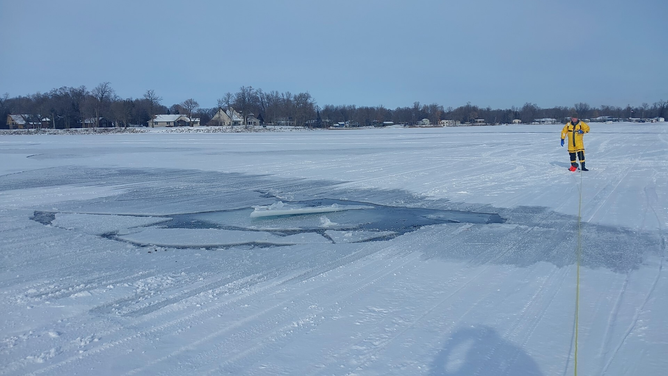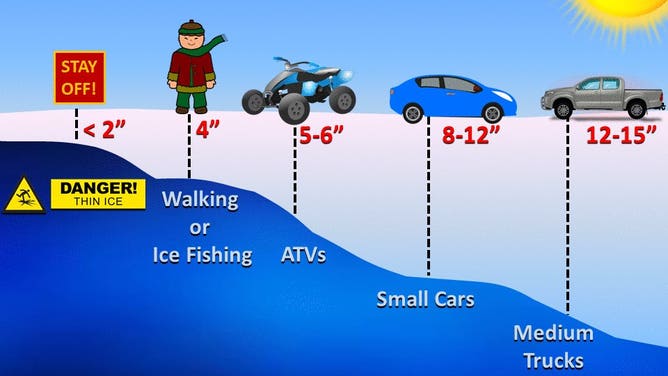Unsafe ice conditions on northern lakes remain despite colder weather
Experts advise you to never venture out on the ice of unknown thickness. At least four inches of ice is needed to support a human’s weight sufficiently, and at least eight inches is recommended before attempting to drive a small-sized vehicle on it.
Invading polar vortex sends dangerous arctic blast across America's Heartland
Frigid temperatures are building across the northern Rockies and Plains where actual air temperatures as low as negative 30 degrees and wind chills as cold as negative 60 degrees have been recorded Friday morning. The brutally cold air will next be pulled south by the strong northerly winds behind the blizzard.
MILACA, Minn. – A Minnesota man is one of the latest victims to perish after venturing onto ice that was simply too thin to support the weight of his vehicle on a lake north of Minneapolis.
The Mille Lacs County Sheriff’s Office said they responded to reports of a man who was wearing a flotation device in the frigid waters of Mille Lacs Lake on Friday.
Deputies initially identified the victim as 80-year-old Richard Francis Gadbois and called the incident a tragic accident.
"This is another reminder to the public that ice conditions are not safe for driving cars and trucks on right now. The ice was approximately 6" thick where this tragic incident took place. The recommended guideline for clear ice is 13-17" for a truck. The ice on many lakes across the state is not good clear ice due to rains and warm temperatures," the sheriff’s office said.
THIN ICE: LAKES BEAR IMPACTS FROM WARM WATER

Authorities said a man is dead after he drove his SUV onto thin ice Friday in Mille Lacs Lake.
(Mille Lacs County Sheriff's Office / FOX Weather)
The Land of 10,000 Lakes is not the only state that has dealt with rescues and tragedies involving people on thin ice. Recent deaths have been reported in Wisconsin, New York and Alaska.
The thin ice is a direct result of the record-warm start to the winter, with even the Great Lakes nearly 90% off from where ice coverage should be in mid-January.
The recent arctic blast that will send temperatures well below zero will help solidify ice along the lakes, but experts warn it’ll take an extended period of frigid weather to make them safe.

If ice is below 4" in depth it is advised you stay off.
(National Weather Service / FOX Weather)
"Although temperatures have taken a dip across much of the state, it’s not been long enough for a deep freeze., Fisheries biologists are reporting unsafe ice conditions, including open water, on many lakes in central and southern Minnesota, especially within the metro. Due to this, we recommend anglers wait to head out until ice conditions improve. Colder temperatures into next week will help build sturdier ice, but it will take time," staff with the Minnesota Department of Natural Resources posted on Facebook.
Experts advise you to never venture out on ice of unknown thickness.
At least four inches of ice is needed to support a human’s weight sufficiently, and at least eight inches is recommended before attempting to drive a small-sized vehicle on it.
FISHERMAN DIES AFTER FALLING THROUGH ICE IN NEW YORK
Ice coverage tends to peak between mid-February and March as temperatures start to rebound into the spring.
The staff with Minnesota’s DNR said lake conditions vary from year to year, so it is always best to check the thickness of the ice before you venture out onto it.
